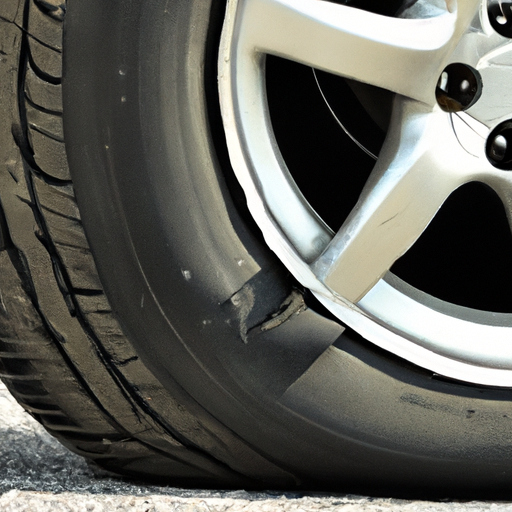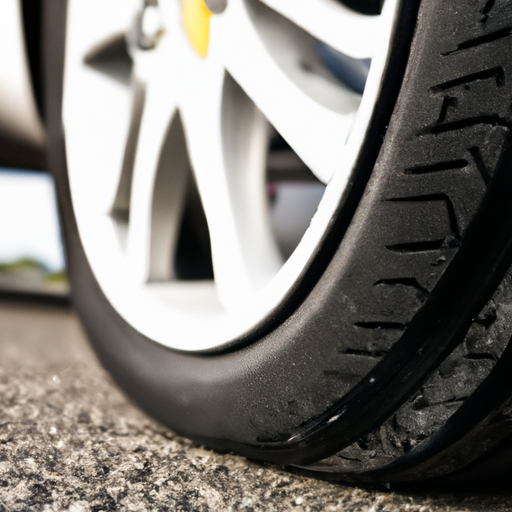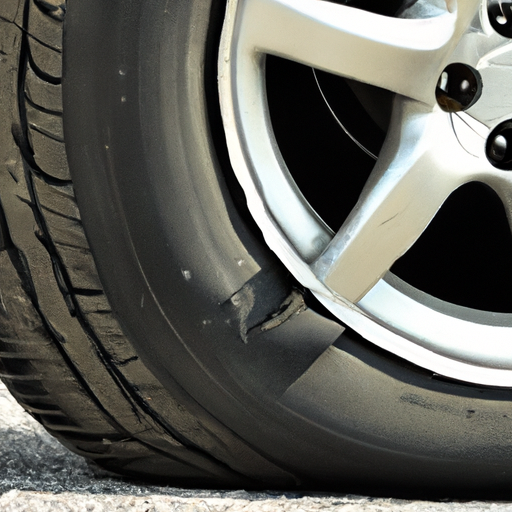Do you ever wonder what could happen if your tires are overinflated? Well, buckle up because this article is here to shed light on the potential risks of overinflated tires. From decreased stability and traction on the road to uneven tire wear and a higher likelihood of a blowout, there are several reasons why it’s important to ensure your tires are properly inflated. So, get ready to learn more about the risks and how to prevent them, so you can stay safe on the road.
1. Increased Risk of Blowouts
Overinflating your tires can significantly increase the risk of blowouts. When tires are overinflated, they become more vulnerable to failure due to the excessive pressure. This can cause the tires to burst, leading to sudden loss of control and potentially dangerous situations on the road.
1.1 Overstressing the Tires
Overinflated tires are subjected to higher than recommended pressure, which puts excessive stress on the tire walls and internal components. This can weaken the tire structure over time, making it more prone to blowouts. The increased stress can also lead to tire damage or even tire disintegration under extreme conditions.
1.2 Reduced Traction
Another risk associated with overinflated tires is reduced traction. When tires are overinflated, the contact patch between the tire and the road decreases. This reduced surface area can result in decreased grip, particularly in wet or slippery conditions. Reduced traction can compromise your ability to accelerate, brake, and maneuver safely, increasing the chances of accidents.
1.3 Uneven Wear and Tear
Overinflated tires tend to wear more in the center of the tread. This is because the excessive pressure causes the center of the tire to carry more weight, leading to uneven wear. Uneven wear not only reduces the overall lifespan of the tire but also compromises its performance. As the tire wears unevenly, its handling and traction capabilities may become unpredictable, making your driving experience less safe and comfortable.
2. Decreased Ride Comfort
Overinflated tires can also significantly impact your ride comfort. When the tire pressure exceeds the recommended level, it can result in a harsh and unresponsive handling experience.
2.1 Harsh and Unresponsive Handling
Overinflation causes the tires to become excessively rigid, reducing their ability to absorb shocks and vibrations from the road surface. As a result, you may feel every bump and imperfection in the road, leading to a harsh and uncomfortable ride. The lack of tire flex also makes the steering feel stiff and unresponsive, making it more challenging to have precise control over the vehicle.
2.2 Increased Vibrations and Road Noise
Another consequence of overinflated tires is increased vibrations and road noise. The rigid tires transmit more road imperfections and vibrations directly to the vehicle’s cabin, resulting in a noisier and less refined ride. These vibrations can also cause discomfort and fatigue, making long journeys unpleasant for you and your passengers.

3. Poor Fuel Efficiency
Overinflated tires can have a detrimental impact on your vehicle’s fuel efficiency. The excessive air pressure reduces the tire’s contact patch with the road, leading to several fuel-related issues.
3.1 Reduced Tire Contact Patch
When tires are overinflated, the center of the tread bulges outward, reducing the overall contact patch with the road surface. This decreased contact patch results in less grip and increased rolling resistance. With reduced traction, your vehicle’s engine has to work harder to maintain speed, ultimately leading to increased fuel consumption.
3.2 Higher Rolling Resistance
Overinflated tires also increase the rolling resistance of the vehicle. Rolling resistance is the force required to keep the tires rolling while the vehicle is in motion. When the pressure is too high, the tires lose their ability to deform and absorb road irregularities, leading to an increase in resistance. This higher rolling resistance translates into more energy and fuel being expended to propel the vehicle forward, ultimately decreasing fuel efficiency.
4. Adverse Effects on Braking Performance
Overinflated tires can negatively impact your vehicle’s braking performance, which is crucial for your safety on the road.
4.1 Longer Stopping Distances
When the tires have too much air pressure, their reduced contact patch results in compromised braking performance. The decreased traction makes it more challenging for the tires to grip the road surface effectively, leading to longer stopping distances. In emergency situations, this can be the difference between avoiding a collision or being involved in a potentially catastrophic accident.
4.2 Reduced Stability and Control
Overinflated tires can also reduce the overall stability and control of your vehicle, especially during braking maneuvers. The lack of proper grip and traction can lead to skidding or sliding, making it difficult to maintain control over your vehicle. This compromised stability can be particularly dangerous on slippery or uneven roads, increasing the risk of accidents and loss of vehicle control.

5. Damage to Suspension and Overall Vehicle
Overinflated tires can cause damage to your vehicle’s suspension system and other crucial components.
5.1 Strain on Suspension Components
When tires are overinflated, they become less effective in absorbing shocks and impacts from the road surface. As a result, the excessive force generated by road irregularities is transmitted directly to the suspension system. This continuous strain on the suspension components can lead to premature wear and damage, requiring costly repairs or replacements.
5.2 Risk of Bouncing or Bottoming Out
Overinflated tires can cause your vehicle to bounce or bottom out on uneven surfaces. The excessive rigidity of the tires prevents them from adequately absorbing road imperfections, causing the vehicle to bounce excessively. This bouncing motion not only compromises ride comfort but can also put additional stress on the suspension system, potentially leading to damage or failure.
6. Negative Impact on Tire Lifespan
Overinflated tires can significantly shorten the lifespan of your tires, resulting in a more frequent need for replacements.
6.1 Increased Wear on the Center Tread
Overinflated tires wear more rapidly in the center of the tread due to the excessive pressure. The center portion of the tire carries disproportionate weight, causing it to wear down at a faster rate compared to the outer edges. This uneven wear not only compromises the tire’s performance but also reduces its overall lifespan. Consequently, you may have to replace your tires sooner than expected, resulting in additional expenses.
6.2 Reduced Longevity of Sidewalls
Aside from the center tread wear, overinflated tires also put additional stress on the sidewalls. The excessive pressure causes the sidewalls to bulge outward, leading to increased flexing and strain on the rubber. This constant flexing weakens the sidewalls over time, making them more susceptible to cracks, bulges, and even tire blowouts. The compromised sidewalls not only reduce the tire’s lifespan but also jeopardize your safety on the road.

7. Potential for Tire Damage and Failure
Overinflated tires pose a higher risk of tire damage and failure, ultimately compromising your safety and the reliability of your vehicle.
7.1 Increased Risk of Tire Blowouts
One of the most significant risks associated with overinflated tires is an increased likelihood of tire blowouts. The excessive air pressure puts immense stress on the tire structure, making it more vulnerable to sudden failure. A tire blowout can occur at any time, leading to loss of control, vehicle instability, and potentially catastrophic accidents.
7.2 Sidewall and Bead Damage
Overinflated tires can also cause damage to the sidewalls and bead areas. The increased pressure causes the sidewalls to bulge and the beads to separate from the wheel, compromising the tire’s integrity. When the sidewalls or beads are damaged, the tire’s ability to maintain proper grip and stability is compromised, increasing the risk of accidents and tire failure.
8. Unsafe Driving Conditions
Overinflated tires can create unsafe driving conditions, making it more challenging to control and maneuver your vehicle safely.
8.1 Reduced Handling and Control
When tires are overinflated, their reduced contact with the road surface diminishes their grip and traction. As a result, your vehicle may exhibit less predictable handling characteristics, making it more difficult to control. The reduced control can be particularly dangerous during emergency maneuvers or when encountering unexpected hazards on the road.
8.2 Increased Hydroplaning Risk
Overinflated tires are more prone to hydroplaning, which occurs when a layer of water builds up between the tires and the road surface, resulting in loss of traction. The decreased contact patch of overinflated tires reduces their ability to channel water effectively, increasing the chances of hydroplaning. Hydroplaning greatly reduces your vehicle’s control, making it more difficult to steer or brake and significantly increasing the risk of accidents on wet roads.

9. Legal Consequences
Overinflating your tires can have legal consequences, as it violates tire safety regulations and can pose liability in accidents.
9.1 Violation of Tire Safety Regulations
Various jurisdictions have specific regulations regarding tire safety, including recommended tire pressures. Overinflating your tires not only compromises your safety but also violates these safety regulations. In the event of an accident or inspection, you may be subject to fines or penalties for non-compliance with tire safety standards.
9.2 Potential Liability in Accidents
Overinflated tires can contribute to accidents and may increase the liability if you are found to be at fault. If it is determined that the overinflated tires played a role in the accident, you could face legal consequences, including financial responsibility for damages and potential lawsuits. It is essential to prioritize tire safety to ensure your own well-being and avoid potential legal issues.
10. Importance of Regular Tire Pressure Checks
To avoid the risks associated with overinflated tires, it is crucial to regularly check and maintain proper tire pressure.
10.1 Maintaining Proper Inflation
Regularly checking and maintaining proper tire pressure is essential for optimal safety and performance. Referencing your vehicle’s manual or the tire manufacturer’s recommendations, ensure that your tires are inflated to the correct pressure level. This will help prevent overinflation and its associated risks, as well as underinflation, which also poses dangers.
10.2 Regular Visits to the Air Pump
To ensure the longevity and safety of your tires, make it a habit to visit the air pump regularly. This will allow you to adjust the tire pressure as necessary to maintain the optimal levels recommended by the vehicle manufacturer. By incorporating this simple routine into your regular maintenance schedule, you can significantly reduce the risks associated with overinflated tires and enjoy a safer and more comfortable driving experience.
In conclusion, overinflating your tires can have severe consequences that affect your safety, vehicle performance, fuel efficiency, and financial liabilities. The risks of blowouts, decreased ride comfort, poor fuel efficiency, adverse effects on braking performance, damage to suspension and overall vehicle, negative impact on tire lifespan, potential tire damage and failure, unsafe driving conditions, legal consequences, and the importance of regular tire pressure checks all highlight the significance of maintaining proper tire inflation. By regularly checking and adjusting your tire pressure, you can ensure your safety on the road, extend tire longevity, and enjoy a smoother, more efficient driving experience. Remember, the health of your tires plays a vital role in the overall well-being of your vehicle, so prioritize tire maintenance for your own peace of mind.


